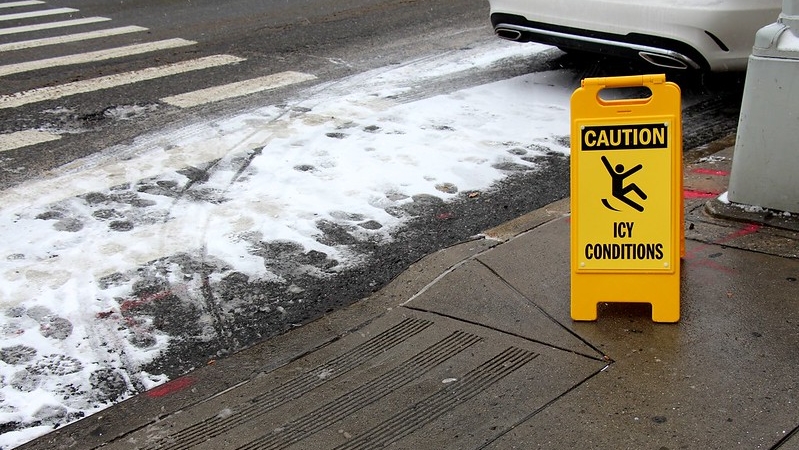Through the company motto “Roads Keep You Moving”, Be Green customers are getting the message that Be Green is Always on Time. Winter can make you more likely to slip, trip, and fall, leading to very serious injuries. You can help keep you safe by taking some simple precautions and reducing these risks in Calgary.
Table of Contents
Tips to Prevent Ice-Related Falls
Clear Snow From Sidewalks and Walkways Promptly
Clearing snow and ice from sidewalks and walkways right away helps prevent dangerous, slippery surfaces. Untreated walkways quickly turn icy, increasing the risk of slips and falls for everyone. Shovel regularly after snowfall, especially during heavy storms, and use salt or sand to keep the ground safer for walking. Not only does it make your walkways safer but it also can keep you out of trouble with Calgary Bylaw.1

Be Aware of Black Ice
Black ice is very nearly invisible, so take caution and consider the possibility that all surfaces may be slippery. Walk with attention and extra precaution on large and unsealed areas.
Stick to Designated Walkways
Use designated paths and walkways whenever possible, that have been treated for ice. Salt or sand is applied to common (public and private) paths in order to reduce slipperiness; thus these are safer to traverse!
Take Small, Slow Steps
Shorter steps and a slower pace also help to keep your feet where your presence is needed the most when going over or on ice. Over the years I have learnt to avoid rushing in order not to slip on something or something else.
Have Good Traction on Your Footwear
It’s freezing, so the right footwear is important. If you’ll be navigating especially icy terrain, consider looking for boots or shoes with really strong treads or even ice spikes if you can.
Avoid Distractions
Just keep your mind on the path ahead of you and go with it. Don’t text or check your phone, and don’t carry things around that block your view. The difference between staying upright and everybody slipping is staying focused on each step.
What to Do if You Fall
If you get caught up slipping and you hit the ground, you’ll want to remain calm and check yourself to see how you’re doing. Take time to sit still and find out if you’re in pain or injured. If you’re alone, go slowly, and without too much pain, see if you can get up. Assisting someone who has fallen—keep them warm before trying to help them up. Call 911 or your local emergency number for them if they are in significant pain or if head injury is involved.
Fall Related Injuries First Aid
If you suffer a minor injury, follow the RICE Method to speed up your recovery and minimize discomfort:2
- REST: Stop all activities working and don’t move or stretch area that got injured.
- IMMOBILIZE: Prevent further strain to the injured area.
- COOL: On the first two days, apply ice packs or cold compresses for up to 20 minutes each hour. On the other hand, use a cloth or towel to avoid frost bite between the ice and skin.
- ELEVATE: While it can be done, try to keep the injured body part raised above your heart level so that it stays swollen.
A day or two after a fall there can be bruises or sore muscles. Some injuries don’t have symptoms immediately, so if you have pain and it’s not going away, then contact your healthcare provider.
Recognizing Serious Injuries: Fractures and Sprains
If a fall results in any of the following symptoms, seek immediate medical assistance:3
- At time of injury, a pop or snap is audible.
- Deformity, swelling, or bruising that is visible
- Pain that is very bad or where there is not much or no movement in your injured area.
- Skin showing bone fragments.
- Bones feeling like they are grinding or grating
- An unusual shortening or twisting of a limb
- Spasms or cramps that occur in the muscles near the injury
- Pinching or weakness around the injured area
Getting quick medical attention can prevent any further damage, and can help with proper healing.
Understanding Concussions: Causes, Diagnosis, and Recovery
A mild traumatic brain injury is a concussion which is usually caused by a blow, bump or jolt to the head. When the brain hits the skull so suddenly, it inside the skull and this disrupts normal brain function. Falls, car accidents, contact sports or any blow to the head or body that shakes the brain around in the skull are the most common causes of concussion.4
Causes of Concussions
- Falls: Especially in young children and old adults, a leading cause.
- Sports Injuries: Contact sports such as football, hockey, soccer and boxing have high risk of concussion.
- Vehicle Collisions: Concussive injuries occur in a fair number of accidents that involve cars, motorcycles, bicycles or pedestrians.
- Violent Shaking: Brain skull collisions are caused by high force movements like whiplash.
Diagnosing a Concussion
Sometimes when a person gets a concussion, the symptoms don’t appear immediately, and it can be hard to diagnose. Healthcare providers will often:
- Evaluate Symptoms: That includes checking for confusion, dizziness, headaches, nausea, sensitivity to light or noise, feelings of being ‘their head is swollen’ or other signs that something is wrong with their head, memory issues and feeling unwell.
- Conduct Neurological Exams: Intake of vision, hearing, balance, coordination and reflexes as a tool to track brain function.
- Perform Cognitive Tests: Cognitive impairment is tested by presenting people with questions to ask — and checking their concentration, recall and problem solving ability.
- Use Imaging (if severe): Imaging like CT or MRI scans isn’t always needed, but can be ordered if it’s suspected that there was severe brain injury or bleeding.
Recovery: Physical and Mental Rest After a Concussion
The first 48 hours require absolute rest for the brain to recover from concussion injuries. Patients need to minimize physical along with mental exertion which intensifies symptoms while reducing exposure to screens and reading and maintaining extreme exercise restriction. Absolute dark-room confinement stands against medical recommendations because both treatment time and mental state experience setbacks.
After your symptoms show improvements you should start light physical activity by either walking or using a stationary bike. Work your way toward more challenging workout activities while keeping an eye on whether your symptoms return. You should stay away from activities with high risk until you fully recover. Having another head impact during this rest period threatens to produce a more serious brain-related injury known as second-impact syndrome.
The healthcare provider will design your personalized recovery plan with specifics about your daily schedule involving brief work hours and regular rest periods and decreased screen time. Healthcare providers also evaluate particular challenges to detect vision problems and balance concerns as well as memory issues then offer recovery recommendations that include vestibular rehabilitation alongside occupational therapy and cognitive exercise programs.
Important Reminder: Early intervention and following your healthcare provider’s advice are key to a successful recovery. Be patient with the healing process and avoid rushing back into normal activities. If symptoms persist or worsen, seek immediate medical attention.
Take Precautions, Stay Alert, and Walk Safely
By following these safety tips and learning how to deal with injuries you’ll be able to travel more confidently on an icy road. As you prepare for winter, you should know that preparation and awareness are your best defenses against your slips, trips and falls.5
Citations.
Feature Photo by SmartSignBrooklyn, licensed under CC BY 2.0
- Bylaws related to snow and ice. (n.d.). https://www.calgary.ca ↩︎
- Fall prevention: Simple tips to prevent falls. (n.d.). Mayo Clinic. https://www.mayoclinic.org ↩︎
- Bone fractures. (2025, January 24). Cleveland Clinic. https://my.clevelandclinic.org ↩︎
- Wright, S. (2023, August 17). Concussions: symptoms and treatment. WebMD. https://www.webmd.com ↩︎
- Larson, J. (2020, November 18). Running in winter: benefits and protection strategies. Healthline. https://www.healthline.com/ ↩︎



